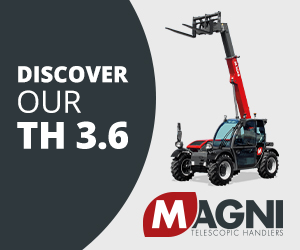The Go-Anywhere Machine: Terex’s TX5519 boasts productivity-enhancing features
Part One
Two years ago, only a couple of compact telescopic handlers were available to North American buyers. Today, more than 30 models from at least a dozen manufacturers are being promoted to the construction and rental markets. During 2005, I reviewed several of these machines, including the Ingersoll-Rand VR-518, the Manitou MT 523, and Terex's TX5519, which appears here. Watch for my review of the VR-518 in the next issue of 360.
Introduced in spring 2004, the Terex TX5519 compact telehandler replaced its predecessor, the TX5119, offering numerous productivity-enhancing features with its new design. Manufactured in the Terex plant in Perugia, Italy, the compact yet rugged TX5519 incorporates an innovative cab design with a rounded profile, ergonomically designed interior, and easy-to-use joystick controls.
The TX5519 features a 5,500-pound maximum lifting capacity, 18'10” maximum lift height, and 11'3” maximum forward reach. With three drive modes to choose from • two-wheel, four-wheel, or crab • the TX5519 is extremely maneuverable. An inside turning radius of 5'6”, coupled with very compact 5'11”x6'4” dimensions, means there are few places this unit can't go. It rides on 12- x 16.5-inch air-filled tires with foam filling as an option. Fenders are standard equipment and made of a composite material.
The engine sits under a fiberglass hood that is hinged so it opens front to back, providing open access to all service points, including the starter. However, if you already own or plan to buy one of these units, make sure you keep the hood latched when not servicing the engine • we can only guess what would happen if it's left untethered on the back of a transport, cruising down the highway at 65 mph.
Terex's TX5519 carries the distinction of being the only unit available in North America that does not have a water-cooled engine. Power comes from a 63-hp Deutz F4M2011 oil-cooled diesel engine. A Rexroth closed loop hydrostatic drive system powers Dana Spicer-supplied front and rear axles. The front axle features a limited slip differential. Drawbar p ull is rated at more than 10,000 pounds.
The boom has been slightly offset to allow for more cab space. This also shows that the assembly uprights are much wider than the boom they support, which is intended to allow for a wider stability point.

In the cab
My test unit was equipped with an open cab designed to meet ROPS & FOPS safety standards. It is spacious for two reasons: The added width is enhanced by a very high roofline, and there was plenty of head room for my 6'4” frame. Although the engine housing sits relatively high when the boom is down, I didn't find right-side visibility to be a problem. Wherever you might find a blind spot, you also will find oversized mirrors to compensate for them. The visibility feature coupled with its compact size and excellent turning radius made this machine a very productive tool.
However, there was one drawback from the wide-open cab and close orientation – engine noise. Deutz engines are not known for being quiet, and the cab's close proximity and the absence of sound insulation in the engine compartment might make the noise level objectionable to some. With that said, an optional closed cab is available. A suspension seat and a tilt steering wheel also come standard.

Lifting tasks
The drive system is set up so that when the brake pedal is depressed, it automatically disengages the drive. You cannot start the engine if the brake is disengaged. The boom controls are a pilot hydraulic system, and a single joystick performs all boom-related functions, including auxiliary functions, very smoothly and precisely. A new larger hydraulic pump is designed to deliver 17-gpm continuous flows to auxiliary-powered attachments, supplying both quick operation and the ability to multifunction. It also powers the universal quick-attach system for numerous skid steer attachments.
The boom is a simple two-section, box-style dry running construction. The hoses are well organized, and they are bulk-headed on the frame for easy service or replacement.
Auxiliary hydraulic quick attachment system is standard, and it allows the operator to sit in the cab and quickly and effortlessly hook and unhook any mechanical attachments. Once in place, the lock pins are also hydraulically actuated, which is about a 15-second task. The auxiliary lines easily pop on and off.
A 48-inch fork frame with 48-inch forks is included in the base price. A wide range of forks, buckets, and, of course, a universal skid steer attachment plate are available as options.

Likes
- Spacious cab complemented with mirrors limits visibility problems.
- A new hydraulic pump delivers 17-gpm continuous flows to auxiliary-powered attachments for quick multi-function operation.

Dislikes
- Cab's close proximity and the absence of sound insulation in the engine compartment made the noise level seem high.

Verdict
- The TX5519 is compact yet rugged with an innovative cab design, ergonomic interior, and easy-to-use joysticks.
Part Two
Two years ago, only a couple of compact telescopic handlers were available to North American buyers. Today, more than 30 models from at least a dozen manufacturers are being promoted to the construction and rental markets. During 2005, I reviewed several of these machines, including the Manitou MT 523, Terex's TX5519, and the Ingersoll Rand VR-518, which appears here.
In mid-2002, Ingersoll-Rand, Davidson, N.C., introduced the VR-518 telescopic handler, one of the first truly “compact” telehanders to have success in North American construction and rental markets.
Produced at Ingersoll-Rand's Ponchateau, France, production facility, the VR-518's maximum capacity is 5,500 pounds and offers a maximum lift height of 18'2”. With standard tires, this machine provides a maximum forward reach of 10'8” from the front of the tires, a maximum vertical reach below grade of 12 inches, and a maximum reach at maximum height of 3'6” from the front of the tires to 24 inches of load center. The two-section boom is designed with a high-rotation carriage, exhibiting exceptional digging ability at 8,093 pounds of break-out force.
As is the case with all the compact telehandlers reviewed, the low-boom mount allows excellent right-side visibility, and a high-mounted, fully-enclosed cab allows visibility to all sides of the machine. It is available with a fully certified ROPS and FOPS open-cab design. A fully enclosed cab is also an option.

Operation
Powering the VR-518 is a 106-hp Perkins 1004.4OT turbocharged engine, which seems like a lot of power for a machine of this size. The engine is mounted transversely to the frame, contributing to its wider build – about 6 inches wider than many of its peers. I found all engine-related service points to be exceptional.
The VR-518 utilizes a smooth-operating Sauer-Danfoss hydrostatic drive that allows the accelerator pedal to be used for automatic gear variation, and the single-pedal design can be used for inching and braking. Operators have the option of two driving ranges: one for power and one for speed. Also featured on the VR-518 are three modes of steering: two-wheel, four-wheel, and crab.
Operator controls are clear and well-positioned, and standard creature comforts in the cab include a tilt steering wheel and dual-padded armrests. Molded plastic is used extensively throughout the interior of the cab. A full set of analog gauges are present to keep the operator fully informed of all critical engine vitals. Plexiglas is utilized in the windshield, boom side window, and overhead view window.
Boom operation is available via a single, multi-function, pilot-pressure Rexroth-supplied joystick. Boom lift, telescope, and auxiliary functions are pilot controlled, while the carriage tilt is electro-hydraulic. A hydraulic quick-attach system allows the VR-518 operator to easily change out attachments without leaving the cab; the operator only needs to leave the cab if the attachment is hydraulically driven. Precise control of the boom made the carriage quick attachment system very easy to use.
The hydraulic disconnects for the hydraulic link are large, and I found them very easy to release. Also note that if the red rubber caps are used, they will help limit the amount of grit and grime that attaches itself to the oil residue common to a hydraulic coupling and helps to keep the process effortless. The operator has the ability to depressurize the auxiliary hydraulic system from the cab, and a manual relief valve also has been placed on the chassis adjacent to the couplings, making it possible to attach any hydraulically driven attachment easily.
Wet disk brakes are located on all four wheels. While operating the unit, I appreciated the very wide brake pedal. In addition, the mechanical parking brake is on an isolated circuit.
The VR-518 features air-filled tires as standard, and it was designed with a planetary drive, four-wheel enclosed wet disk brakes, and a “No Drive Through” parking brake. A double-acting steer cylinder increases ground clearance, and it is positioned to limit the chance of damage.
Ingersoll-Rand believes that most injuries occur when the operator falls out of the cab during a rollover, so for added safety, a supplemental restraint device is incorporated into the operator's left-hand armrest. The armrest swings up when exiting and then down once you are seated, blocking interlock, drive, and boom functions until the bar is in its locked position. The restraint device provides a physical barrier to help prevent the operator from exiting the cab at the wrong time. Like your car's airbag, it is not intended to take the place of the seatbelt that you are required to wear.
In addition to the Bobcat attachment line, other optional features for the VR-518 include a 48- or 60-inch shaft carriage, a rotating beacon, a windshield guard, and standard or low-profile tires. With low-profile tires, the VR-518 can clear overhangs as low as 7 feet.

Bobcat Versahandler V518
Ingersoll-Rand's sister company Bobcat, West Fargo, N.D., also has a compact telescopic handler in its product line: the Versahandler V518 telescopic tool carrier. Aside from the paint color and nomenclature, the Bobcat V518 and the Ingersoll-Rand VR-518 are virtually identical.
Featuring a 5,000-pound capacity and 18'2” lift height, the V518 combines the agility of a skid steer with the reach of a telehandler to perform a number of jobs in the agricultural and construction markets. Its wide range of attachments and hydraulic Quick-Tach attachment connector add to the V518's versatility.
Overall dimensions of this compact machine include a 6'11” cab height, 6'6” width, and 14'5” length from the fork heel to the rear of the machine. The V518's maximum forward reach measures 10'8”, and at its maximum height, the maximum reach is 3'6” from the front of the tires to 24 inches of load center. The unit also provides 8,093 pounds of break-out force.
Also powering this unit is the 100-hp Perkins 1104C-44T turbocharged diesel engine. A four-wheel drive hydrostatic transmission provides for smooth operation. Steering modes on the Versahandler V518 include front-wheel, four-wheel opposed, and crab.

Likes
High-rotation carriage contributes to exceptional digging ability at 8,093 pounds of break-out force.
Hydrostatic drive allows the accelerator pedal to be used for automatic gear variation, and the single-pedal design can be used for inching and braking. Wide brake pedal made operation easier.

Dislikes
Powering the VR-518 is a 106-hp Perkins 1004.4OT turbocharged engine, which seems like a lot of power for a machine of this size. The engine is mounted transversely to the frame, contributing to its wider build – about 6 inches wider than many of its peers.

Verdict
As an early entry into the compact telehandler market, the VR-518 set the design stage for other machines to come.











